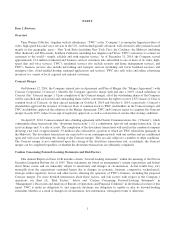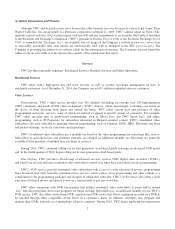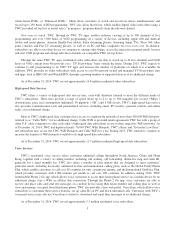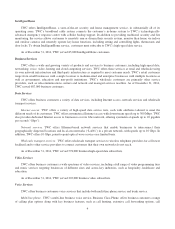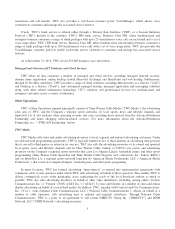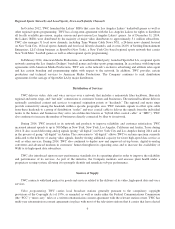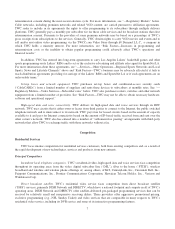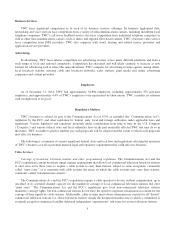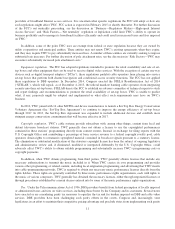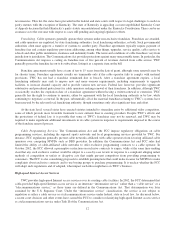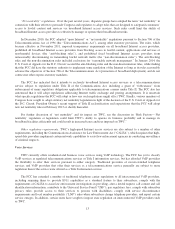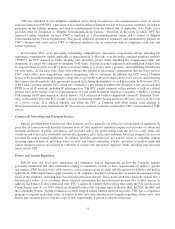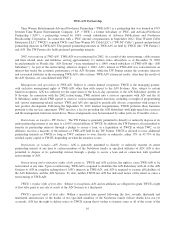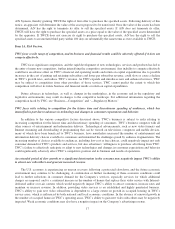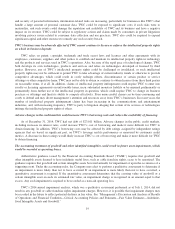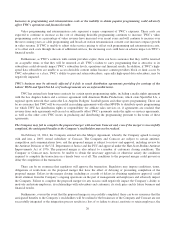Time Warner Cable 2014 Annual Report Download - page 18
Download and view the complete annual report
Please find page 18 of the 2014 Time Warner Cable annual report below. You can navigate through the pages in the report by either clicking on the pages listed below, or by using the keyword search tool below to find specific information within the annual report.In March 2011, the FCC initiated a rulemaking proceeding to reform its retransmission consent rules, based, in part,
on a petition submitted by a coalition of fourteen public interest groups and multi-channel video programming distributors
(“MVPDs”), including TWC. In March 2014, the FCC revised its rules to provide that joint negotiation of retransmission
consent by stations that are ranked among the top four stations in a market (as measured by audience share) and are not
commonly owned constitutes a violation of the statutory duty to negotiate retransmission consent in good faith. The FCC
also sought further comment on whether to modify or eliminate its network non-duplication and syndicated exclusivity
rules in light of changes in the video marketplace. TWC is unable to predict what additional action, if any, the FCC might
take in connection with retransmission consent.
The Communications Act also permits franchising authorities to negotiate with cable operators for channels for
public, educational and governmental access programming. It also requires a cable system with 36 or more activated
channels to designate 15 percent of its channel capacity for commercial leased access by third parties, which limits the
amount of capacity TWC has available for other programming and other uses. The FCC regulates the rates and some
terms and conditions of third-party commercial use of TWC’s channel capacity. Revisions to such rules adopted in 2008
requiring substantial reduction to the rates TWC can charge for leased access have been stayed pursuant to an appeal in
the U.S. Court of Appeals for the Sixth Circuit. If implemented, these regulations could significantly increase the
Company’s costs and burdens associated with leased access requirements.
Program carriage. The Communications Act and the FCC’s “program carriage” rules restrict cable operators and
MVPDs from unreasonably restraining the ability of an unaffiliated programming vendor to compete fairly by
discriminating against the programming vendor on the basis of its non-affiliation in the selection, terms or conditions for
carriage. In August 2011, the FCC issued an order, which, among other things, established rules regarding what a
complaint must demonstrate to establish a prima facie case of a program carriage violation and established procedures for
consideration by the FCC’s Media Bureau of a complainant’s request for a temporary standstill of the price, terms and
other conditions of an existing programming contract pending the FCC’s resolution of a complaint proceeding. In
September 2013, the court vacated the FCC’s temporary standstill rules, finding that they were promulgated in violation
of the Administrative Procedure Act of 1946. The FCC’s August 2011 order also contained a notice of proposed
regulations that could further expand program carriage regulation. This rulemaking proceeding remains pending, and
TWC is unable to predict what additional action, if any, the FCC might take in connection with program carriage.
Subscriber rates. The Communications Act and the FCC’s rules regulate and limit the rates that TWC may charge
for basic cable service and equipment in communities that are not subject to “effective competition,” as defined by federal
law. Where there has been no finding by the FCC of effective competition, federal law authorizes franchising authorities
to regulate the monthly rates charged by the operator for the minimum level of video programming service, referred to as
basic service tier or BST, which generally includes local broadcast television signals, satellite-delivered broadcast
networks and superstations, local origination channels, a few specialty networks and public access, educational and
government channels. This regulation also applies to the installation, sale and lease of equipment used by subscribers to
receive basic service, such as set-top boxes and remote control units. As of December 31, 2014, the FCC has determined
that approximately 85% of the communities TWC serves are subject to “effective competition.”
Pole attachment regulation. The Communications Act requires that investor-owned utilities provide cable systems
and telecommunications carriers with non-discriminatory access to any pole, conduit or right-of-way controlled by those
utilities. The Communications Act permits the FCC to regulate the rates, terms and conditions imposed by these utilities
for cable systems’ and telecommunications carriers’ use of utility poles and conduit space. States are permitted to preempt
FCC jurisdiction over pole attachments through certifying that they regulate the terms of attachments themselves. Many
states in which TWC operates have done so. Rates for attachments used to provide “cable” services and
“telecommunications” services are calculated under different provisions of the Communications Act, and the rates for
telecommunications attachments have historically been higher than the rates for cable attachments. In January 2014, the
FCC sought comment on a petition filed by Union Electric Company regarding the legal classification of Voice over
Internet Protocol (“VoIP”) services for purposes of assessing pole attachment rates. The matter remains pending before
the FCC. It is uncertain when the FCC will rule on this issue or how any regulation it adopts might affect TWC. The FCC
recently indicated that its forthcoming “net neutrality” or “Open Internet” order would apply pole attachment regulation to
10



